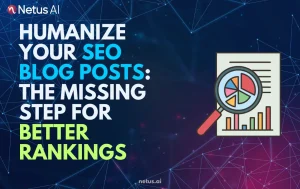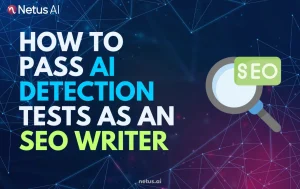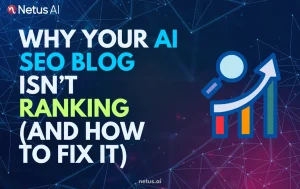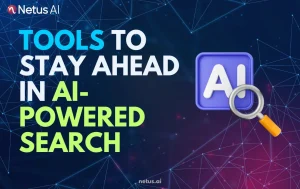
Google’s Helpful Content Update: An SEO Writer’s Guide | NetusAI
SEO Writer’s Guide to Google’s Helpful Content Update Keeping up with Google’s algorithm changes can feel like a relentless game of whack-a-mole. Just when you
What is AI Detection? An Overview of Automated Detection
Technology

Content writer and editor for Netus.AI
What is AI Detection? AI detection refers to the use of artificial intelligence (AI) technology to identify and classify objects, patterns, or anomalies in data. AI detection systems are becoming increasingly popular in a wide range of industries, from healthcare to finance to security. These systems use machine learning algorithms to analyze large amounts of data and detect patterns that are difficult or impossible for humans to identify.
One of the key advantages of AI detection is its ability to process vast amounts of data quickly and accurately. This makes it an invaluable tool for applications such as fraud detection, where AI detectors can quickly identify unusual patterns and flag potential cases for further investigation. In healthcare, AI detection systems can be used to analyze medical images and identify early signs of disease, potentially improving patient outcomes and saving lives.
Despite its many benefits, AI detection is not without its challenges. One of the biggest concerns is the potential for bias in the algorithms used to train these systems. If the data used to train an AI detector is biased in some way, the system may produce inaccurate or unfair results. As such, it is important to carefully consider the data used to train AI detection systems and ensure that it is representative of the real world.
AI detection refers to the use of artificial intelligence (AI) to identify and flag potentially problematic content. This can include identifying instances of plagiarism, detecting fake news, and flagging inappropriate or offensive content. AI detection is becoming increasingly important as the volume of online content continues to grow, and the need to monitor and regulate that content becomes more pressing.
The significance of AI detection lies in its ability to automate the process of content analysis and flagging. This can save significant amounts of time and resources, while also improving the accuracy of content moderation. Additionally, AI detection can help to identify patterns and trends in problematic content, allowing for more targeted interventions and preventative measures.
While AI detectors and plagiarism checkers both use AI to identify problematic content, there are some key differences between the two. Plagiarism checkers are specifically designed to identify instances of plagiarism, while AI detectors are more broadly focused on identifying a range of problematic content.
AI detectors are also generally more advanced and sophisticated than plagiarism checkers, using a range of techniques such as natural language processing and machine learning to identify problematic content. This allows them to identify a wider range of issues, including instances of AI-generated content and other forms of content manipulation.
Despite these differences, both AI detectors and plagiarism checkers play an important role in content moderation and ensuring the integrity of online content. By automating the process of content analysis and flagging, they help to ensure that online content remains accurate, reliable, and trustworthy.
There are a range of AI detection tools available, each with their own strengths and weaknesses. Some popular AI detection tools include:
When selecting an AI detection tool, it’s important to consider factors such as accuracy, ease of use, and cost. Additionally, it’s important to ensure that the tool is compatible with the specific needs and requirements of your organization.
Overall, AI detection is an important tool for ensuring the accuracy, reliability, and trustworthiness of online content. By automating the process of content analysis and flagging, AI detection tools can help to save time and resources, while also improving the accuracy of content moderation.
One of the key technologies behind AI detection is the use of advanced algorithms and language models. These models are designed to analyze large amounts of data and identify patterns that can be used to detect specific types of content. For example, some language models can be trained to identify hate speech or other forms of offensive language, while others can be used to detect plagiarism or other types of academic misconduct.
One of the most promising language models currently under development is GPT-4, which is being developed by OpenAI. This model is designed to be even more advanced than the current state-of-the-art model, GPT-3, and is expected to be able to perform a wide range of tasks, including text completion, translation, and summarization.
Another important technology behind AI detection is the use of AI writing tools. These tools are designed to help writers improve the quality of their writing by providing suggestions for grammar, syntax, and style. Some of the most popular AI writing tools currently available include ChatGPT and Grammarly.
ChatGPT is an API that allows developers to build chatbots and other conversational AI applications. It is based on the GPT-3 language model and is designed to be highly customizable, allowing developers to create chatbots that can handle a wide range of tasks.
Grammarly, on the other hand, is a popular tool for writers that provides suggestions for grammar, syntax, and style. It uses advanced algorithms to analyze text and provide suggestions for improvement, and is widely used by both professional and amateur writers alike.
Overall, the use of advanced algorithms and AI writing tools is helping to revolutionize the field of AI detection. As these technologies continue to develop and improve, we can expect to see even more sophisticated and accurate detection systems in the future.
AI detection has become increasingly important in the field of education. With the rise of online learning, educators are turning to AI to help monitor and assess student work. AI detection algorithms can analyze student work for plagiarism, grammar errors, and even evaluate the quality of writing. This helps educators save time and improve the accuracy of their assessments.
Students can also benefit from AI detection in education. By using AI-powered tools, students can receive instant feedback on their work and improve their writing skills. Additionally, AI can help identify areas where students may need additional support, allowing educators to tailor their teaching to individual student needs.
Universities are also using AI detection to maintain academic integrity. By using AI-powered plagiarism detection software, universities can ensure that students are submitting original work. This helps to maintain the academic standards of the institution and protect the integrity of the degrees they award.
AI detection is also being used to combat the spread of fake news and misinformation. By analyzing the content of articles and social media posts, AI algorithms can identify false or misleading information. This helps to protect the public from harmful information and ensures that accurate information is being disseminated.
Publishers are also using AI detection to ensure the authenticity of the content they publish. By using AI-powered tools, publishers can verify the authenticity of images and videos used in their publications. This helps to prevent the spread of false information and maintain the credibility of the publication.
In conclusion, AI detection has a wide range of practical applications in education, publishing, and content authenticity. By using AI-powered tools, educators, students, universities, and publishers can save time, improve accuracy, and maintain academic integrity.
One of the major challenges in AI detection is dealing with false positives. False positives occur when the AI system incorrectly identifies an object or event as a threat or anomaly when it is not. This can lead to unnecessary alarms and alerts, which can cause confusion and waste valuable resources.
To minimize the occurrence of false positives, AI detection systems must be designed to accurately distinguish between normal and abnormal behavior. This requires careful tuning of the system’s parameters and thresholds, as well as the use of machine learning algorithms that can adapt to changing conditions.
Another challenge in AI detection is the accuracy of the system in different languages. AI detection systems must be able to accurately detect and analyze threats and anomalies in multiple languages, including English, Spanish, German, and French.
To achieve this, AI detection systems must be trained on large datasets of language-specific threats and anomalies. They must also be able to adapt to new and emerging threats and anomalies, which requires ongoing monitoring and analysis of the system’s performance.
Overall, the reliability of AI detection systems depends on the percentage of true positives and false positives. To improve the reliability of AI detection systems, it is important to carefully consider these and other challenges, and to continuously refine and improve the system’s algorithms and parameters.
As technology continues to advance, the future of AI detection is looking bright. With the help of advanced algorithms and artificial intelligence, AI detection software is becoming more accurate and efficient in detecting various forms of data.
One area where AI detection is gaining popularity is in the detection of AI writing. AI writing detectors are becoming increasingly sophisticated in their ability to detect text generated by AI, which is becoming more prevalent in today’s digital landscape. This technology is particularly useful for businesses and organizations that need to ensure that the content they publish is original and not generated by AI.
In addition to AI writing detectors, AI detectors are also becoming more user-friendly. These detectors are designed to be easy to use, even for individuals who are not tech-savvy. With a user-friendly interface, AI detectors can be used by anyone to detect various forms of data, from text to images and videos.
The future of AI detection is not limited to just these areas. As technology continues to advance, AI detection software will become more advanced in detecting various forms of data, making it easier for businesses and organizations to stay on top of emerging trends and threats.
Overall, the future of AI detection is looking bright, with the potential to revolutionize the way businesses and organizations detect and respond to various forms of data.

SEO Writer’s Guide to Google’s Helpful Content Update Keeping up with Google’s algorithm changes can feel like a relentless game of whack-a-mole. Just when you

Can AI Content Be Safe for SEO in 2025? Let’s start with the question of keeping every content strategist, SEO pro and blogger awake at

Humanize Your SEO Blog Posts: The Missing Step for Better Rankings You’ve done everything by the book. Your keyword research is impeccable. Your meta descriptions

How to Pass AI Detection Tests as an SEO Writer Let’s paint a familiar picture. You’ve just finished a blog post. The headline is sharp,

Why Your AI SEO Blog Isn’t Ranking (And How to Fix It) You embraced AI for your blog. The promise was intoxicating: high-quality content, published

The Modern SEO Writer’s Stack: Tools to Stay Ahead in AI-Powered Search Remember the days when “SEO writing” conjured images of frantic keyword stuffing, awkward
@ 2024 Netus AI.